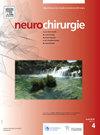Trends and development of enhanced recovery after surgery programs in cranial and spinal neurosurgery
IF 1.4
4区 医学
Q4 CLINICAL NEUROLOGY
引用次数: 0
Abstract
Background
Enhanced Recovery After Surgery (ERAS) has garnered considerable attention and demonstrated substantial clinical benefits across multiple surgical specialties. However, its integration into cranial and spinal neurosurgery remains nascent and fraught with challenges. This study aims to systematically assess the current research landscape, identify emerging hotspots, and forecast future directions for ERAS in neurosurgery through comprehensive bibliometric analysis. These findings seek to inform clinical practice and guide future investigations.
Methods
Relevant publications indexed in the Web of Science Core Collection from January 1, 1999, to December 1, 2024, were analyzed. Bibliometric tools, primarily CiteSpace, were utilized to evaluate annual publication trends, author and institutional contributions, journal dissemination, keyword co-occurrence, and citation network structures.
Results
A total of 273 articles were included. The analysis reveals that ERAS implementation in spinal neurosurgery has reached a relatively advanced stage, while its application in cranial procedures remains underdeveloped, yet promising. The United States and China are leading in publication output, although China’s global influence is comparatively limited. Key research themes include hospital length of stay, cost-effectiveness, postoperative complication management, and multimodal analgesia. Anticipated trends suggest a growing focus on personalized ERAS protocols tailored to specific neurosurgical conditions and enhanced patient engagement in recovery processes.
Conclusion
Through bibliometric and visualization techniques, this study offers a comprehensive overview of ERAS-related neurosurgical research, delineating its evolution and thematic shifts. The insights derived herein may facilitate strategic planning, foster interdisciplinary collaboration, and promote evidence-based advancements in perioperative neurosurgical care.
颅脊神经外科手术后增强恢复的趋势和发展
手术后增强恢复(ERAS)已经引起了相当大的关注,并在多个外科专业中显示出实质性的临床效益。然而,它与颅脑和脊柱神经外科的结合仍处于初期阶段,充满了挑战。本研究旨在通过综合文献计量分析,系统评估神经外科ERAS的研究现状,识别新兴热点,并预测未来发展方向。这些发现旨在为临床实践提供信息并指导未来的研究。方法对Web of Science Core Collection 1999年1月1日至2024年12月1日收录的相关出版物进行分析。文献计量工具(主要是CiteSpace)用于评估年度出版趋势、作者和机构贡献、期刊传播、关键词共现和引文网络结构。结果共纳入文献273篇。分析表明,ERAS在脊柱神经外科的应用已达到较先进的阶段,而在颅脑外科的应用仍不发达,但前景广阔。尽管中国的全球影响力相对有限,但美国和中国在出版物产量方面处于领先地位。主要研究主题包括住院时间、成本效益、术后并发症管理和多模式镇痛。预期的趋势表明,针对特定神经外科条件量身定制的个性化ERAS方案日益受到关注,并增强了患者在康复过程中的参与度。通过文献计量学和可视化技术,本研究提供了erass相关神经外科研究的全面概述,描绘了其演变和主题转变。本文得出的见解可以促进战略规划,促进跨学科合作,并促进围手术期神经外科护理的循证进步。
本文章由计算机程序翻译,如有差异,请以英文原文为准。
求助全文
约1分钟内获得全文
求助全文
来源期刊

Neurochirurgie
医学-临床神经学
CiteScore
2.70
自引率
6.20%
发文量
100
审稿时长
29 days
期刊介绍:
Neurochirurgie publishes articles on treatment, teaching and research, neurosurgery training and the professional aspects of our discipline, and also the history and progress of neurosurgery. It focuses on pathologies of the head, spine and central and peripheral nervous systems and their vascularization. All aspects of the specialty are dealt with: trauma, tumor, degenerative disease, infection, vascular pathology, and radiosurgery, and pediatrics. Transversal studies are also welcome: neuroanatomy, neurophysiology, neurology, neuropediatrics, psychiatry, neuropsychology, physical medicine and neurologic rehabilitation, neuro-anesthesia, neurologic intensive care, neuroradiology, functional exploration, neuropathology, neuro-ophthalmology, otoneurology, maxillofacial surgery, neuro-endocrinology and spine surgery. Technical and methodological aspects are also taken onboard: diagnostic and therapeutic techniques, methods for assessing results, epidemiology, surgical, interventional and radiological techniques, simulations and pathophysiological hypotheses, and educational tools. The editorial board may refuse submissions that fail to meet the journal''s aims and scope; such studies will not be peer-reviewed, and the editor in chief will promptly inform the corresponding author, so as not to delay submission to a more suitable journal.
With a view to attracting an international audience of both readers and writers, Neurochirurgie especially welcomes articles in English, and gives priority to original studies. Other kinds of article - reviews, case reports, technical notes and meta-analyses - are equally published.
Every year, a special edition is dedicated to the topic selected by the French Society of Neurosurgery for its annual report.
 求助内容:
求助内容: 应助结果提醒方式:
应助结果提醒方式:


